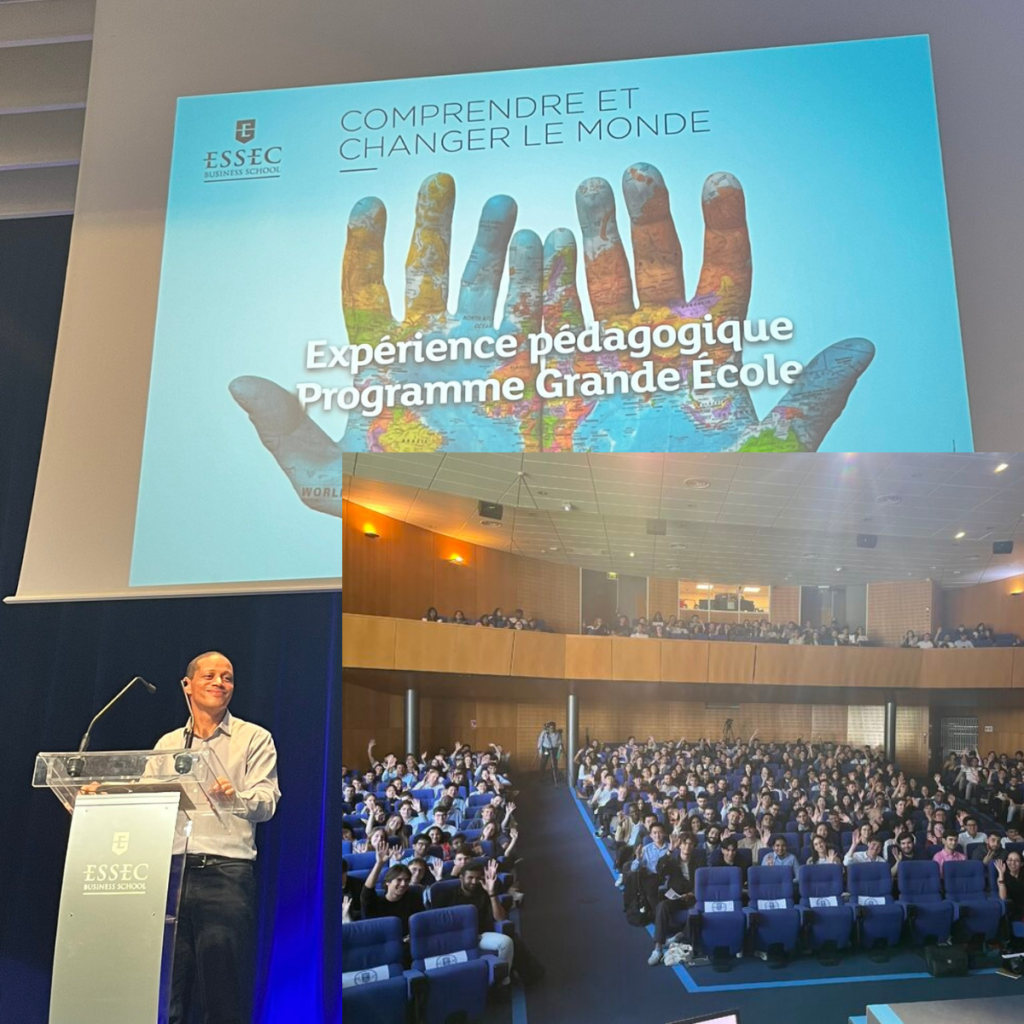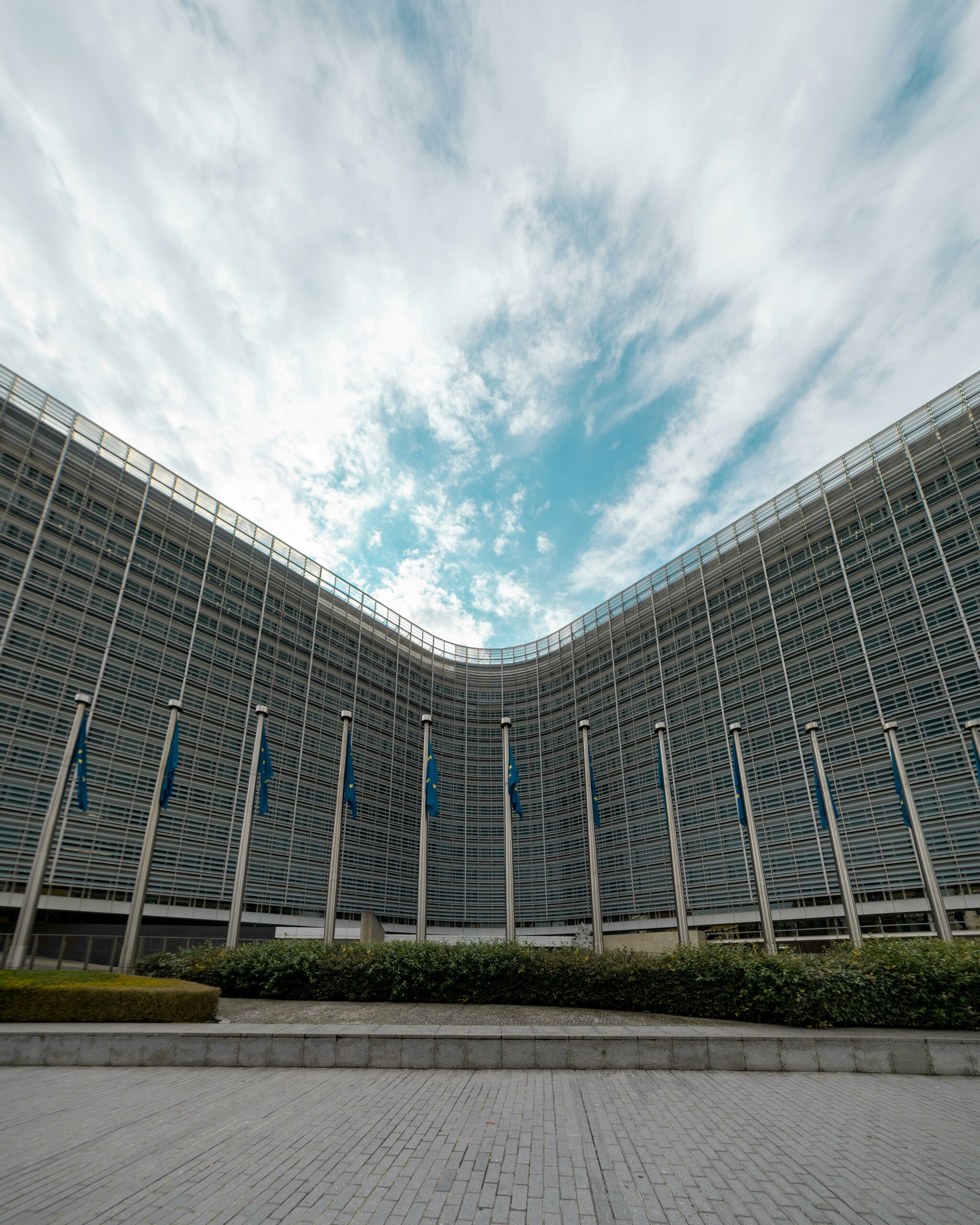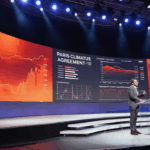As part of our advocacy activities, we regularly speak to influential audiences who are in a position to contribute to a fairer, more sustainable economic world. Feedback on a plenary session at the annual ” Understanding and Changing the World ” seminar at Essec business school.
Back to basics: the 1972 Meadows report
Faced with a youth audience inundated with information on sustainable development issues, it’s always useful to return to a few reference points. The Meadows report is one of them. Firstly, because it anchors collective awareness of the role of economic activities in environmental depletion around one date: 1972. Secondly, by reviewing the report’s main conclusions, an audience that is not necessarily an expert in these matters can quickly understand how, over the long term, the directions outlined in the report remain relevant and contemporary 50 years on.
“The Limits to Growth” is a groundbreaking report published in 1972 by the Club of Rome, an international think tank. The report was the result of a project initiated by the Club of Rome, a group of scientists, economists, and other professionals, and was conducted at the Massachusetts Institute of Technology (MIT). The primary focus of “The Limits to Growth” was to explore the implications of exponential growth in population, industrialization, pollution, food production, and resource consumption on a finite planet. The report utilized 1900-1970 computer modeling to project potential future scenarios based on different assumptions regarding these key factors. The study warned of the potential consequences of continued growth in population and resource consumption, suggesting that if growth were to continue unabated, it would lead to ecological and economic collapse within the foreseeable future. The report proposed that humanity needed to establish sustainable development strategies to ensure a balance between population growth, resource utilization, and environmental preservation.
“The Limits to Growth” brought attention to sustainability issues and was highly influential in shaping the early environmental movement, policy discussions, and subsequent research in the field of sustainable development. However, it was also criticized for its assumptions, methodologies, and predictions, and subsequent revisions and updates to the report have taken place over the years. In particular, the various scenarios proposed in this report already point to a civilizational change to be expected around the years 2015-2030. And here we are. Here are the main scenarios described in the report:
- Business-as-Usual (BAU): In this scenario, the world continues with its existing growth trends in population, industrialization, and resource consumption without significant changes in policies or behaviors. This scenario leads to a collapse of the global system due to resource depletion and environmental degradation.
- Stabilized World: This scenario explores a future where the world takes measures to reduce population growth and stabilize industrial and agricultural development. The population stabilizes and environmental impact is reduced, leading to a more sustainable future.
- Technological Fix: This scenario assumes that technological advancements alone can solve the challenges posed by exponential growth. It envisions a world where rapid technological development helps overcome resource scarcity and environmental issues. However, this scenario still has limits to growth, albeit delayed.
- Conserver Society: In this scenario, significant efforts are made to reduce resource consumption and waste. There is a focus on sustainable development, conservation, and a shift toward a more ecologically conscious society.
The report analyzed these scenarios to understand potential outcomes in terms of population growth, industrial output, pollution levels, resource depletion, and overall sustainability. It emphasized the importance of managing growth and achieving a sustainable balance between human activities and the finite resources of the planet.
Since 1972, several sustainability milestones have obviously contributed to refine and reshape global priorities. To name a few, the 1987 Brundtland Report defined sustainable development, underlining intergenerational equity – thus connecting environmental agenda with social considerations. The 1992 Earth Summit in Rio de Janeiro consolidated global environmental governance and international agreements. The Millennium Development Goals (2000) incorporated environmental sustainability. The 2012 Rio+20 conference stressed a balanced integration of economic, social, and environmental dimensions. A landmark moment arrived in 2015 with the adoption of the 2030 Agenda for Sustainable Development, featuring 17 SDGs, each pivotal for a sustainable future. The Paris Agreement (2015) galvanized worldwide efforts to combat climate change. The COVID-19 pandemic (2020) underscored the imperative for sustainable recovery and resilience. Finally, the UN Decade on Ecosystem Restoration (2021-2030) was launched to combat biodiversity loss and climate change through large-scale ecosystem restoration efforts, showcasing ongoing commitment to sustainability. These milestones depict an evolving global consciousness towards sustainable practices and a harmonious relationship with the planet.
We are living through the civilizational change anticipated in the Meadow Report. Now.
Under pressure from society and regulations, companies are being urged to change and put environmental and social issues at the heart of their thinking. Recruitment managers are astonished by the virulence of the questions and positions of young people during recruitment interviews on these issues. The EU CSRD imposes on a wide range of large companies and SMEs throughout the European Union, and wishing to trade with the EU, the need to prioritize ESG issues, report information on these issues, and take a stand to limit impacts. A young group of executives destined to take on decision-making roles in these environments are thus beginning their professional careers in an environment that cannot ignore these social and environmental issues.
In response, corporations today face a pressing need to embrace transformational change and adapt to social and environmental planetary boundary constraints for several compelling reasons:
- Sustainability Imperative:
- Global Challenges: Climate change, loss of biodiversity, resource scarcity, and social inequality are significant global challenges. Corporations must contribute to addressing these challenges to secure a sustainable future.
- Regulatory Environment:
- Stringent Regulations: Governments and international bodies are implementing stricter regulations related to environmental protection, emissions reduction, waste management, and social responsibility. Non-compliance can lead to legal, financial, and reputational risks.
- Market Expectations and Consumer Demand:
- Informed Consumers: Modern consumers are increasingly informed and concerned about sustainability. They prefer products and services from companies with environmentally and socially responsible practices, influencing purchasing decisions.
- Reputation and Brand Value:
- Reputation Management: Embracing sustainability positively impacts a company’s reputation and brand value. Consumers, investors, and stakeholders favor companies with a strong commitment to sustainability and responsible business practices.
- Risk Mitigation and Resilience:
- Supply Chain Risks: Disruptions in supply chains due to climate-related events or resource scarcity can have adverse effects. Embracing sustainability helps mitigate these risks and ensures a more resilient business model.
- Cost Efficiency and Innovation:
- Resource Efficiency: Adopting sustainable practices often leads to cost savings through improved resource efficiency, waste reduction, energy savings, and streamlined operations.
- Innovation and Market Opportunities: Sustainable practices drive innovation, creating new markets and business opportunities through the development of eco-friendly products and services.
- Attracting Talent and Employee Engagement:
- Talent Attraction and Retention: Millennials and younger generations prioritize working for organizations that demonstrate a commitment to sustainability and social responsibility.
- Employee Engagement: Employees are more engaged and motivated when working for a company that aligns with their values and contributes positively to society and the environment.
- Investor Pressure:
- Investor Expectations: ESG (Environmental, Social, and Governance) factors are now central to investment decisions. Investors increasingly consider a company’s sustainability performance as a key determinant of financial performance and long-term value.
- Long-Term Business Viability:
- Resource Scarcity and Business Continuity: Corporations need to secure access to finite resources for long-term business viability. Sustainable practices help ensure resource availability and business continuity.
- Global Collaboration and Partnerships:
- International Cooperation: Global challenges require collective action. Corporations collaborating with governments, NGOs, and other stakeholders can drive impactful solutions and address planetary boundaries effectively.
Embracing sustainability and adapting to social and environmental planetary boundary constraints is not just an ethical choice but a strategic necessity for corporations. Those that proactively and genuinely integrate sustainability into their business strategies are more likely to thrive, remain competitive, and contribute positively to the planet and society.
What kind of leadership and skills are needed to drive sustainable business transformation?
Leading transformational change within corporations to adapt to social and environmental planetary boundary constraints requires a specific set of leadership qualities and competencies. Here are key aspects that leaders should focus on to effectively navigate and drive sustainable transformation:
- Visionary Leadership:
- Creating a Compelling Vision: Develop and articulate a clear and inspiring vision that aligns with sustainability goals and respects planetary boundaries.
- Fostering Long-Term Thinking: Encourage a long-term perspective that prioritizes sustainable growth and societal well-being over short-term gains.
- Strategic Thinking and Planning:
- Systems Thinking: Understand and address complex interconnections and systems dynamics related to environmental, social, and economic aspects.
- Sustainable Business Models: Explore and develop business models that integrate sustainability into core operations and strategies.
- Collaboration and Stakeholder Engagement:
- Building Partnerships: Collaborate with stakeholders, NGOs, governments, and communities to collectively address sustainability challenges and drive positive change.
- Engaging Employees: Involve employees at all levels in sustainability initiatives, fostering a sense of ownership and collective responsibility.
- Change Management Skills:
- Change Communication: Effectively communicate the need for change, the vision, and the benefits of sustainability to gain support and commitment from stakeholders.
- Resilience and Adaptability: Be resilient and adaptable in the face of resistance or setbacks, adjusting strategies as needed to stay on course.
- Ethical and Responsible Leadership:
- Integrity and Ethics: Demonstrate integrity, honesty, and ethical behavior in all interactions, aligning actions with the organization’s sustainability commitments.
- Accountability: Hold oneself and others accountable for achieving sustainability goals and meeting planetary boundary constraints.
- Innovation and Creativity:
- Encouraging Innovation: Foster a culture of innovation that encourages the development of sustainable products, processes, and technologies.
- Creativity in Problem-Solving: Encourage creative solutions to sustainability challenges, considering unconventional approaches and perspectives.
- Emotional Intelligence and Empathy:
- Empathy and Understanding: Understand and consider the perspectives and needs of diverse stakeholders, including marginalized communities and the environment.
- Conflict Resolution: Effectively manage conflicts by addressing concerns and finding mutually beneficial solutions.
- Learning and Development Orientation:
- Continuous Learning: Promote a culture of continuous learning and growth, encouraging employees to acquire knowledge and skills related to sustainability.
- Personal Development: Invest in leadership development programs focused on sustainability and planetary boundary constraints.
- Risk Management and Resilience:
- Anticipating Risks: Anticipate and mitigate risks associated with sustainability challenges and changes in the global environmental landscape.
- Building Resilience: Develop strategies to enhance the organization’s resilience in the face of environmental and social uncertainties.
- Advocacy and Thought Leadership:
- Influential Advocacy: Advocate for policy changes and industry practices that support sustainability and respect planetary boundaries.
- Knowledge Sharing: Share knowledge, experiences, and best practices to influence and inspire others in the industry toward sustainable transformation.
Successful transformational leadership in the realm of sustainability involves a blend of strategic foresight, collaboration, ethical decision-making, innovative thinking, and a strong commitment to driving positive change that aligns with the planet’s ecological limits.
Conclusion
The Meadows report was already outlining a civilizational change that would take place between 2015 and 2030. We are there now. We can, and should, deplore as much as question the inertia that led us to acknowledge that, 50 years ago, we already had enough information to change an unsustainable mode of economic development. It’s not too late. In fact, we can now hope to benefit from a more favorable environment, forced by cold reality, to bring about faster, more radical transformations. Leadership and skills are decisive. It’s not for young people to judge and criticize what previous generations have done. They did what they could do. Young people must understand, analyze, challenge, criticize, propose, take the initiative, test and deploy. Change the world.
Author of several books and resources on business, sustainability and responsibility. Working with top decision makers pursuing transformational changes for their organizations, leaders and industries. Working with executives improving resilience and competitiveness of their company and products given their climate and human right business agendas. Connect with Farid Baddache on Twitter at @Fbaddache.






